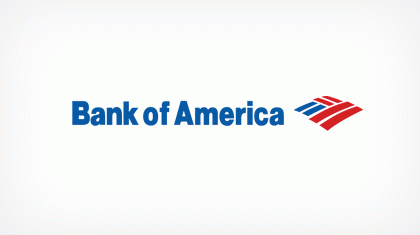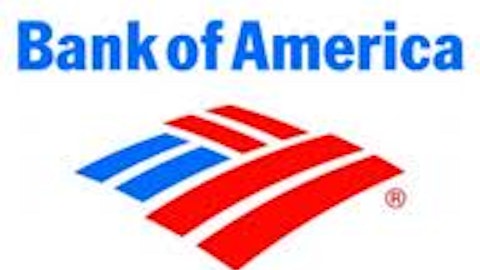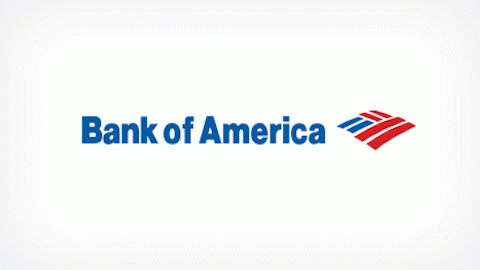After collapsing in value during the recession, Bank of America Corp (NYSE:BAC) has been given a front row seat to the financial meltdown. But while BofA has managed to recover some lost ground, shares still have lagged the Dow Jones Industrial Average as the index hit a new record high. With a rebuilding housing market, settlement of many outstanding lawsuits, and the possibility of a stronger economy to come, many investors are looking for new ways to go long on Bank of America. Not to worry, BofA has three different mid to high risk options for the BofA bull.
Medium Risk: Bank of America Stock
Since 2007, Bank of America Corp (NYSE:BAC) shares have taken quite a beating. After topping $50 per share in late 2006, BofA shares fell back through the $50 level in early 2007. Since then it has not seen anywhere near that level again. Shares currently change hands in the mid-$11 range and have remained under $13 for over a year. This has left the question in many investors’ minds: what’s keeping BofA shares down?

However, things aren’t all negatives at Bank of America. The bank has attracted a multi-billion dollar investment from famed investor Warren Buffett. Of course he got a much better deal than any average investor could. Why? Because he made a $5 billion investment, and he is Warren Buffett. A name like his adds prestige to any company, and Bank of America Corp (NYSE:BAC) was glad to have “free” use of his name. But Buffett continues to hold his BofA investment (which he is well in the black, by the way), meaning he must still see the bank as a good investment.
Why might Buffett see BofA as a good investment? One possible reason is a steep discount to book value. Closing at $11.55 on March 5, BofA shares are well below their book value of $21.98, and even below their tangible book value of $14.33. While questions still linger about how much of this book value is worth what Bank of America Corp (NYSE:BAC) says it is, the investment from Buffett is a sign that the bank still has a strong foundation and should be able to weather near term potential threats.
Mid to High Risk: Bank of America Class A Warrants (NYSE:BAC-AW)
For the more aggressive BofA investor, the guys who brought you TARP have brought you another BofA investment option. BofA warrants can trace their origin back to the bank bailout terms when they were issued to the U.S. government as part of the terms to receive taxpayer dollars. Yet, BofA did not want the stigma of being even partially owned by Uncle Sam, and Uncle Sam did not want the stigma of partially owning Bank of America Corp (NYSE:BAC). So the BofA warrants were auctioned by the Treasury ,and now typical investors have access to these long dated warrants.
Class A Warrants carry a strike price of $13.30, expire on Jan. 16 2019, and have the strike price adjusted downward for dividends in excess of one cent per quarter. Although out of the money at the moment, the strike price is actually below BofA’s tangible book value. To add to that, the strike price adjustment may begin to take effect in the upcoming quarters as the bank will likely be looking to raise its dividend from the current one cent per quarter. Closing at $5.66 on March 5, the Class A Warrants have a breakeven around $19 per share. For aggressive Bank of America Corp (NYSE:BAC) investors, two times leverage for this breakeven might make a good investment.
High Risk: Bank of America Class B Warrants (NYSE:BAC-BW)
If Bank of America Class A Warrants were for the aggressive investor, Bank of America Class B Warrants would be for the ultra-super-aggressive investor. These warrants have a similar origin as the Class A Warrants but carry a much higher strike price and less favorable strike price adjustment terms.
Not surprisingly, the market is pricing these warrants much lower than their Class A cousins. With a strike price of $30.79, BofA shares are currently a long way from the strike price. Additionally, the dividend required to begin adjusting the strike price is $0.32 per quarter and the warrant expiry date is Oct. 18, 2018. But a closing price of just under $0.73 each on March 5 gives investors the opportunity to leverage BofA shares around 15 times.
These warrants are only for the most aggressive BofA speculators. Those who foresee BofA surging in value over the next five years on the back of earnings growth and reduced uncertainty may find a play into the high risk end of BofA investments attractive. Even though share dilution from the bailout will make regaining its pre-recession highs more difficult, if Bank of America Corp (NYSE:BAC) can draw upon its Merrill Lynch and Countrywide acquisitions to stop producing lawsuits and start producing profits, coordination with the BofA financial powerhouse could begin generating strong earnings for the banking giant once again. For this reason, I will not dismiss the Class B Warrants–rather, I will classify them in the high risk category where many other speculative, yet profitable, investments have originated from.
Bank of America- Bank of Opportunity
This BofA slogan also makes a good summary for the ways to invest in BofA. Investors who want to play BofA with less risk can buy BofA shares to profit from earnings growth and collect the penny per quarter dividend until the bank is given approval to increase it. Less risk adverse investors may want to leverage their exposure to BofA with the warrants available on the open market. Either way, if BofA can put its last ugly few years behind it, the recovery that has pushed the Dow northward could extend to Bank of America over the coming months and years.
A Note on Bank of America Warrants
When writing about warrants, specifically financial bailout based ones, many investors are interested in where they can find the warrants for further research. The Bank of America Corp (NYSE:BAC) warrants are publicly traded and can be purchased through most brokerages, online or otherwise. However, the warrants’ ticker symbols are not universal across different platforms, and this has led to some confusion. While not all financial websites list the warrants, they are viewable at Yahoo! Finance as BAC-WTA for the Class A Warrants and BAC-WTB for the Class B Warrants. For more information on the warrants or to find the symbol your brokerage firm lists them as, a quick call to your firm should be enough to get any necessary information to better research your investment.
The article From Shares to 15 Times Leverage: Bank of America originally appeared on Fool.com and is written by Alexander MacLennan.
Copyright © 1995 – 2013 The Motley Fool, LLC. All rights reserved. The Motley Fool has a disclosure policy.



